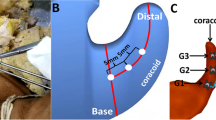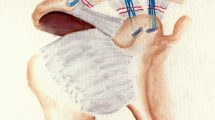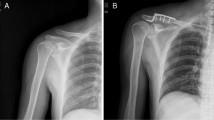Abstract
Background
Suspension suture button fixation was frequently used to treat acromioclavicular joint (ACJ) dislocation. However, there were many studies reporting about complications and residual horizontal instability after fixation. Our study compared the stability of ACJ after fixation between coracoclavicular (CC) fixation alone and CC fixation combined with ACJ repair by using finite element analysis (FEA).
Materials and methods
A finite element model was created by using CT images from the normal shoulder. The model 1 was CC fixation with suture button alone, and the model 2 was CC fixation with suture button combined with ACJ repair. Three different forces (50, 100, 200 N) applied to the model in three planes; inferior, anterior and posterior direction load to the acromion. The von Mises stress of the implants and deformation at ACJs was recorded.
Results
The ACJ repair in the model 2 could reduce the peak stress on the implant after applying the loading forces to the acromion which the ACJ repair could reduce the peak stress of the FiberWire at suture button about 90% when compared to model 1. And, the ACJ repair could reduce the deformation of the ACJ after applying the loading forces to the acromion in both vertical and horizontal planes.
Conclusion
This FEA supports that the high-grade injuries of the ACJ should be treated with CC fixation combined with ACJ repair because this technique provides excellent stability in both vertical and horizontal planes and reduces stress to the suture button.





Similar content being viewed by others
References
Rockwood G, Williams G, Young D (2004) Disorders of the acromioclavicular joint. WB Saunders Co., Philadelphia
Ladermann A, Gueorguiev B, Stimec B, Fasel J, Rothstock S, Hoffmeyer P (2013) Acromioclavicular joint reconstruction: a comparative biomechanical study of three techniques. J Shoulder Elb Surg 22:171–178
Barth J, Duparc F, Andrieu K, Duport M, Toussaint B, Bertiaux S, Clavert P (2015) Is coracoclavicular stabilization alone sufficient for the endoscopic treatment of severe acromioclavicular joint dislocation (Rockwood types III, IV, and V). Orthop Traumatol Surg Res 101(8 Suppl):S297–S303
Barth J, Duparc F, Baverel L, Bahurel J, Toussaint B, Bertiaux S, Clavert P (2015) Prognostic factors to succeed in surgical treatment of chronic acromioclavicular dislocations. Orthop Traumatol Surg Res 101(8 Suppl):S305–S311
Clavert P, Meyer A, Boyer P, Gastaud O, Barth J, Duparc F, The SFA (2015) Complication rates and types of failure after arthroscopic acute acromioclavicular dislocation fixation. Prospective multicenter study of 116 cases. Orthop Traumatol Surg Res 101(8 Suppl):S313–S316
Shin S-J, Kim N-K (2015) Complications after arthroscopic coracoclavicular reconstruction using a single adjustable-loop length suspensory fixation device in acute acromioclavicular joint dislocation. Arthroscopy 31:816–824
Jensen G, Katthagen JC, Alvarado L, Lill H, Voigt C (2013) Arthroscopically assisted stabilization of chronic AC-joint instabilities in GraftRope™ technique with an additive horizontal tendon augmentation. Arch Orthop Trauma Surg 133:841–851
Cho C-H, Kim B-S, Kwon D-H (2016) Importance of additional temporary pin fixation combined coracoclavicular augmentation using a suture button device for acute acromioclavicular joint dislocation. Arch Orthop Trauma Surg 136:763–770
Ferreira JV, Chowaniec D, Obopilwe E, Nowak MD, Arciero RA, Mazzocca AD (2012) Biomechanical evaluation of effect of coracoid tunnel placement on load to failure of fixation during repair of acromioclavicular joint dislocation. Arthroscopy 28(9):1230–1236
Dyrna F, Timm CC, de Oliveira M, Nowak AV, Obopilwe E, Braun S, Pauzenberger L, Imhoff AB, Mazzocca AD, Beitzel K (2018) Risk of fracture of the acromion depends on size and orientation of acromial bone tunnels when performing acromioclavicular reconstruction. Knee Surg Sports Traumatol Arthrosc 26(1):275–284
Abat F, Sarasquete J, Natera LG, Calvo A, Pérez-Espana M, Zurita N, Ferrer J, Real JCD, Paz-Jimenez E, Forriol F (2015) Biomechanical analysis of acromioclavicular joint dislocation repair using coracoclavicular suspension devices in two different configurations. J Orthop Traumatol 16:215–219
Luis GE, Yong C-K, Singh DA, Sengupta S, Choon DS (2007) Acromioclavicular joint dislocation: a comparative biomechanical study of the palmaris-longus tendon graft reconstruction with other augmentative methods in cadaveric models. J Orthop Surg Res 2:22. https://doi.org/10.1186/1749-799x-2-22
Hosseini H, Friedmann S, Tröger M, Lobenhoffer P, Agneskirchner JD (2008) Arthroscopic reconstruction of chronic AC joint dislocations by transposition of the coracoacromial ligament augmented by the Tight Rope device: a technical note. Knee Surg Sports Traumatol Arthrosc 17:92–97
Tsan-Wen Huang MD, Pang-Hsin Hsieh MD, Kuo-Chung Huang P, Kuo-Chin Huang MD (2009) Suspension suture augmentation for repair of coracoclavicular ligament disruptions. Clin Orthop Relat Res 467:2142–2148
Vieira LAG, Visco A, Fernandes LFD, Cordero NGG (2009) Arthroscopic treatment of acromioclavicular joint dislocation by tight rope technique (ARTHREX®). Rev Bras Ortop 44(1):52–56
Hedtmann A, Fett H, Ludwig J (1998) Management of old neglected posttraumatic acromioclavicular joint instability and arthrosis. Orthopade 27(8):556–566
Gerhardt C, Kraus N, Greiner S, Scheibel M (2011) Arthroscopic stabilization of acute acromioclavicular joint dislocation. Orthopade 40(1):61–69
Acknowledgements
All authors declare no funding source or sponsor involvement in the study design, collection, analysis and interpretation of the data, in writing the manuscript, and in submission of the manuscript for publication.
Author information
Authors and Affiliations
Corresponding author
Ethics declarations
Conflict of interest
The authors declare that they have no conflict of interests regarding the publication of this paper.
Rights and permissions
About this article
Cite this article
Sumanont, S., Nopamassiri, S., Boonrod, A. et al. Acromioclavicular joint dislocation: a Dog Bone button fixation alone versus Dog Bone button fixation augmented with acromioclavicular repair—a finite element analysis study. Eur J Orthop Surg Traumatol 28, 1095–1101 (2018). https://doi.org/10.1007/s00590-018-2186-y
Received:
Accepted:
Published:
Issue Date:
DOI: https://doi.org/10.1007/s00590-018-2186-y




